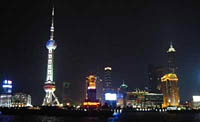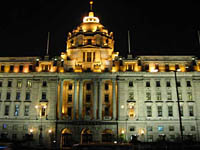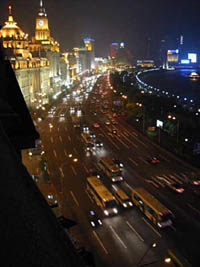End of the Road: Shanghai
Tuesday, 26 April 2005 I left Singapore at the end of March 2005 to travel to Shanghai via Malaysia, Thailand, Cambodia, Vietnam and through China stopping in Macau for a travel conference and Hong Kong. I intended to stick to travel at surface level – buses, trains, boats, whatever came along but definitely no planes.
I left Singapore at the end of March 2005 to travel to Shanghai via Malaysia, Thailand, Cambodia, Vietnam and through China stopping in Macau for a travel conference and Hong Kong. I intended to stick to travel at surface level – buses, trains, boats, whatever came along but definitely no planes.
This is the end of the trip, my short stay in one of the world’s most rapidly changing mega-cities:
What a disappointing finish. The ferry no longer docks at Shiliupu Wharf right in the centre of Shanghai; it terminates at a wharf 25km out. I might as well have taken the high-speed ferry instead of the slow boat to China. My journey concludes with an expensive taxi ride, mixing it with the early rush-hour traffic.
The rest of Shanghai makes up for my initial disenchantment. I stay at the Hangshen Moller Villa, a weird old house built for a rich Swedish businessman back in Shanghai’s ‘International Settlement’ days and now converted into a hotel. ‘A good film set for the Munsters’ is one way of describing it. I’ve been remarkably lucky at turning up at dawn and getting a room instantly, no ‘you can occupy the room at 2pm’ business.
 Since my last visit, the new city of Pudong, across the river from old Shanghai, has grown enormously and many of the showpiece old European buildings along the Bund have been restored to their good old days/bad old days glory. So that’s where I conclude my Singapore-Shanghai trip, with dinner at M at the Bund, the iconic international restaurant of new-old Shanghai, and perhaps of new-old China.
Since my last visit, the new city of Pudong, across the river from old Shanghai, has grown enormously and many of the showpiece old European buildings along the Bund have been restored to their good old days/bad old days glory. So that’s where I conclude my Singapore-Shanghai trip, with dinner at M at the Bund, the iconic international restaurant of new-old Shanghai, and perhaps of new-old China.
Fine dining solo always seems slightly pointless, but the food and wine is superb and between the main course and dessert I run through every journey, every meal, every night, every border and every highlight of the last 28 days. Yes, I can remember every single day for the last month.
 Then I stroll out to the balcony overlooking the Bund: the sweep of buildings brilliantly floodlit; traffic flowing down the Bund; people strolling along the new Bund promenade; a cavalcade of dark working boats and brilliantly lit tourist ones weaving along the river; Pudong, the city of bling, shining in neon splendour as the backdrop.
Then I stroll out to the balcony overlooking the Bund: the sweep of buildings brilliantly floodlit; traffic flowing down the Bund; people strolling along the new Bund promenade; a cavalcade of dark working boats and brilliantly lit tourist ones weaving along the river; Pudong, the city of bling, shining in neon splendour as the backdrop.
Sailing above the whole movie set, I notice three black kites, looking like new-age bats with their blinking red LEDs. Chinese is tonal, so often the same word can have different meanings if the tone is low, medium, high, rising or falling. As a result Chinese humour is full of puns. In Hoi An two weeks ago, in one of the old Chinese shophouses, a guide pointed out the bats carved into the woodwork.
‘It’s happiness,’ he said, ‘the two words are the same, bats mean happiness.’






